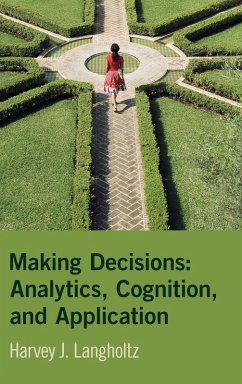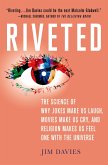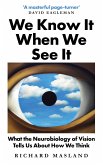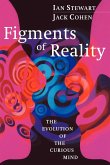Harvey J. Langholtz
Making Decisions: Analytics, Cognition, and Application
Harvey J. Langholtz
Making Decisions: Analytics, Cognition, and Application
- Gebundenes Buch
- Merkliste
- Auf die Merkliste
- Bewerten Bewerten
- Teilen
- Produkt teilen
- Produkterinnerung
- Produkterinnerung
This book provides clear, practical guidance on decision analysis tools and the psychology behind human choices. Learn how to apply these insights to make better personal and professional decisions, understand the logic of optimal choices, and boost your confidence in making them.
Andere Kunden interessierten sich auch für
![Feeling and Knowing Feeling and Knowing]() Antonio DamasioFeeling and Knowing17,99 €
Antonio DamasioFeeling and Knowing17,99 €![Candidate Experience. What do Candidates experience and what do they expect during Application Processes? Candidate Experience. What do Candidates experience and what do they expect during Application Processes?]() Jacqueline MortsieferCandidate Experience. What do Candidates experience and what do they expect during Application Processes?47,95 €
Jacqueline MortsieferCandidate Experience. What do Candidates experience and what do they expect during Application Processes?47,95 €![Goal-Setting Theory and its Application in Organizations Goal-Setting Theory and its Application in Organizations]() Gabriel SochaGoal-Setting Theory and its Application in Organizations15,95 €
Gabriel SochaGoal-Setting Theory and its Application in Organizations15,95 €![Riveted: The Science of Why Jokes Make Us Laugh, Movies Make Us Cry, and Religion Makes Us Feel One with the Universe Riveted: The Science of Why Jokes Make Us Laugh, Movies Make Us Cry, and Religion Makes Us Feel One with the Universe]() Jim DaviesRiveted: The Science of Why Jokes Make Us Laugh, Movies Make Us Cry, and Religion Makes Us Feel One with the Universe24,99 €
Jim DaviesRiveted: The Science of Why Jokes Make Us Laugh, Movies Make Us Cry, and Religion Makes Us Feel One with the Universe24,99 €![We Know It When We See It We Know It When We See It]() Richard MaslandWe Know It When We See It18,99 €
Richard MaslandWe Know It When We See It18,99 €![The International Handbook of Creativity The International Handbook of Creativity]() James C. KaufmanThe International Handbook of Creativity58,99 €
James C. KaufmanThe International Handbook of Creativity58,99 €![Figments of Reality Figments of Reality]() Ian StewartFigments of Reality35,99 €
Ian StewartFigments of Reality35,99 €-
-
-
This book provides clear, practical guidance on decision analysis tools and the psychology behind human choices. Learn how to apply these insights to make better personal and professional decisions, understand the logic of optimal choices, and boost your confidence in making them.
Produktdetails
- Produktdetails
- Verlag: Cambridge University Press
- Seitenzahl: 300
- Erscheinungstermin: 30. September 2025
- Englisch
- ISBN-13: 9781009450874
- ISBN-10: 1009450875
- Artikelnr.: 74171429
- Herstellerkennzeichnung
- Libri GmbH
- Europaallee 1
- 36244 Bad Hersfeld
- gpsr@libri.de
- Verlag: Cambridge University Press
- Seitenzahl: 300
- Erscheinungstermin: 30. September 2025
- Englisch
- ISBN-13: 9781009450874
- ISBN-10: 1009450875
- Artikelnr.: 74171429
- Herstellerkennzeichnung
- Libri GmbH
- Europaallee 1
- 36244 Bad Hersfeld
- gpsr@libri.de
Harvey J. Langholtz is a professor in the Department of Psychological Sciences at William and Mary, specializing in decision theory. He was a commander in the US Coast Guard, a member of the US delegation to the United Nations, and the founding director of a nonprofit nominated for the Nobel Peace Prize.
List of figures
List of tables
Preface
Acknowledgements
Section I. Analytics: Probability, Evaluation, Decision Trees, and Strategies for Decision Making
1. Introduction to decision theory and decision making
2. Thinking like a gambler: for all the gambles of life
3. Using decision trees to see through the forest ahead
4. Strategies for decision making in an environment of risk: how to get the most and avoid the worst, no matter what
Section II. Cognitive Processes of Decision Making
5. Heuristics: assumptions and quick rules of thumb we all use - but maybe shouldn't
6. Prospect theory: psychological aspects beyond expected value
7. Two systems: a descriptive model that explains how people make decisions
8. Decisions are made based on our memories, but how reliable are our memories?
9. Psychology + economics = behavioral economics = ways to (gently) influence decisions
Section III. Applications, Examples, and Selected Topics
10. Signal detection theory: how to detect the important signal against the distracting background and take action
11. Game theory as applied to real-world decisions
12. Decision making under stress: staying ahead of rapidly changing events and making difficult, time-critical decisions
13. Decision making involving disputes, negotiation, and conflict
14. Multi-attribute utility decisions: making complex and multidimensional decisions
15. Common decision traps and how to avoid them
16. Overcoming indecisiveness by understanding what causes it
17. Looking back and looking ahead: what about emotion, culture, artificial intelligence, and intuition?
Bibliography
Index.
List of tables
Preface
Acknowledgements
Section I. Analytics: Probability, Evaluation, Decision Trees, and Strategies for Decision Making
1. Introduction to decision theory and decision making
2. Thinking like a gambler: for all the gambles of life
3. Using decision trees to see through the forest ahead
4. Strategies for decision making in an environment of risk: how to get the most and avoid the worst, no matter what
Section II. Cognitive Processes of Decision Making
5. Heuristics: assumptions and quick rules of thumb we all use - but maybe shouldn't
6. Prospect theory: psychological aspects beyond expected value
7. Two systems: a descriptive model that explains how people make decisions
8. Decisions are made based on our memories, but how reliable are our memories?
9. Psychology + economics = behavioral economics = ways to (gently) influence decisions
Section III. Applications, Examples, and Selected Topics
10. Signal detection theory: how to detect the important signal against the distracting background and take action
11. Game theory as applied to real-world decisions
12. Decision making under stress: staying ahead of rapidly changing events and making difficult, time-critical decisions
13. Decision making involving disputes, negotiation, and conflict
14. Multi-attribute utility decisions: making complex and multidimensional decisions
15. Common decision traps and how to avoid them
16. Overcoming indecisiveness by understanding what causes it
17. Looking back and looking ahead: what about emotion, culture, artificial intelligence, and intuition?
Bibliography
Index.
List of figures
List of tables
Preface
Acknowledgements
Section I. Analytics: Probability, Evaluation, Decision Trees, and Strategies for Decision Making
1. Introduction to decision theory and decision making
2. Thinking like a gambler: for all the gambles of life
3. Using decision trees to see through the forest ahead
4. Strategies for decision making in an environment of risk: how to get the most and avoid the worst, no matter what
Section II. Cognitive Processes of Decision Making
5. Heuristics: assumptions and quick rules of thumb we all use - but maybe shouldn't
6. Prospect theory: psychological aspects beyond expected value
7. Two systems: a descriptive model that explains how people make decisions
8. Decisions are made based on our memories, but how reliable are our memories?
9. Psychology + economics = behavioral economics = ways to (gently) influence decisions
Section III. Applications, Examples, and Selected Topics
10. Signal detection theory: how to detect the important signal against the distracting background and take action
11. Game theory as applied to real-world decisions
12. Decision making under stress: staying ahead of rapidly changing events and making difficult, time-critical decisions
13. Decision making involving disputes, negotiation, and conflict
14. Multi-attribute utility decisions: making complex and multidimensional decisions
15. Common decision traps and how to avoid them
16. Overcoming indecisiveness by understanding what causes it
17. Looking back and looking ahead: what about emotion, culture, artificial intelligence, and intuition?
Bibliography
Index.
List of tables
Preface
Acknowledgements
Section I. Analytics: Probability, Evaluation, Decision Trees, and Strategies for Decision Making
1. Introduction to decision theory and decision making
2. Thinking like a gambler: for all the gambles of life
3. Using decision trees to see through the forest ahead
4. Strategies for decision making in an environment of risk: how to get the most and avoid the worst, no matter what
Section II. Cognitive Processes of Decision Making
5. Heuristics: assumptions and quick rules of thumb we all use - but maybe shouldn't
6. Prospect theory: psychological aspects beyond expected value
7. Two systems: a descriptive model that explains how people make decisions
8. Decisions are made based on our memories, but how reliable are our memories?
9. Psychology + economics = behavioral economics = ways to (gently) influence decisions
Section III. Applications, Examples, and Selected Topics
10. Signal detection theory: how to detect the important signal against the distracting background and take action
11. Game theory as applied to real-world decisions
12. Decision making under stress: staying ahead of rapidly changing events and making difficult, time-critical decisions
13. Decision making involving disputes, negotiation, and conflict
14. Multi-attribute utility decisions: making complex and multidimensional decisions
15. Common decision traps and how to avoid them
16. Overcoming indecisiveness by understanding what causes it
17. Looking back and looking ahead: what about emotion, culture, artificial intelligence, and intuition?
Bibliography
Index.








